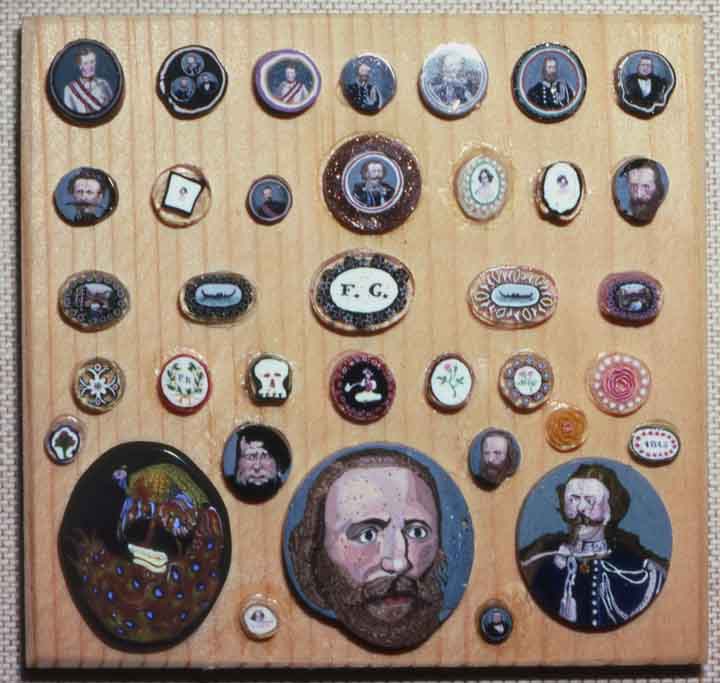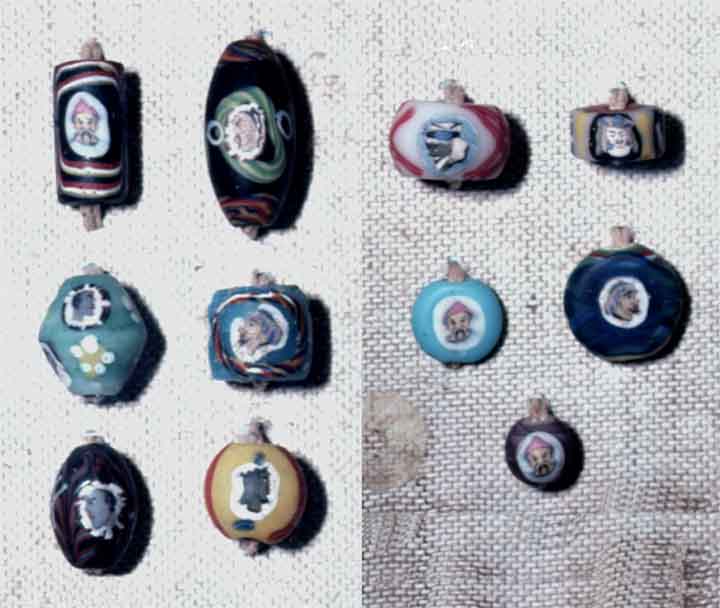| Franchini Canes - And Franchini Beads? | |||||
| Post Reply | Edit | View All | Forum | ||
11/09/2009, 20:40:56
Carroll wrote a bit about Jocomo Franchini, the remarkable canemaker who spent most of his career creating miniature portraits in glass of famous people of the time, and of various Venetian sights. Although Franchini was the son of a beadmaker, remarkably few of his canes were used on beads (though there are a few). In any event, he was in-part responsible for the grand revival of millefiori work that commenced in the mid-19th C. We should always remember that Franchini made canes—but he did not produce many articles that USED those canes as decorative units. What mostly remained after his death were the canes themselves.
By about Carroll's time and perhaps as late as the 1920s, Franchini's work was still admired, and pieces of his canework were used in a series of poorly-made artifacts; and collections of specimens (disks from portrait canes) were placed into presentation boxes that were sold or presented to important people as gifts. Although I originally wrote about Carroll and Franchini in the mid-1980s, that work was not published and was superceeded by later efforts, such as Miniature de Vetro and other books discussed here recently.
Nevertheless, my article still provides a lot of useful information (on beadmaking and the Venetian industry), and I recommend it. Among the illustrations I present, is a group of Franchini cane-disks, showing various personages. We can see it here in color, below. (Please note, the peacock in the lower left is NOT from a Franchini cane!)
I speculate that because of the revival of Franchini's popularity (as late as the 1920s), a new series of face canes was produced, that were used on beads, perfume bottles, and other artifacts. The faces represent a variety of racial types, and people of various status (including the Pope). However, the workmanship of these canes is really poor, in comparison to Franchini's work. It is difficult for me to believe that anyone would mistake one for the other..., but, nevertheless, this routinely happens. (That is to say, it has been my experience a number of times that people have shown me these later beads and bottles, stating that the portraits are by Franchini. And when I have disagreed, they are sometimes somewhat scandalized, or object to my correction.) As usual, I am not trying to say the later beads are ugly nor worthless. I am saying they are something different, that they are from later times, and do not represent the work of Jocomo Franchini. But these confusions persist.
Presently, a bead is being offered at the Trades Page here, and I have been contacted by a potential buyer, who had assumed the bead has Franchini canes on it. The seller does not imply this at all (!), but the mistaken identity should be expected as inevitable.
Here's another photograph showing a group of the late Venetian face beads. I have both of these images through the kindness of Gianni de Carlo of Venice, who brought me into his home in 1990, and allowed me to photograph his collections—which are quite impressive. I wish I had been a better photographer then..., but in fact I was not a terrific photo-technician at that time. So, the photos are what they are.
I hope this is instructive and helpful.
Jamey

